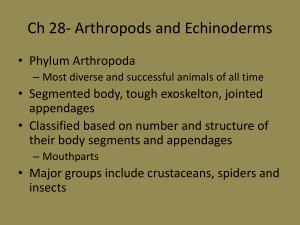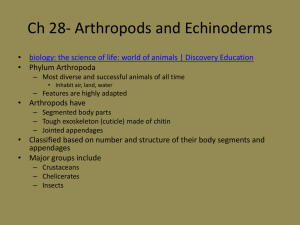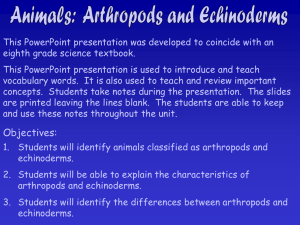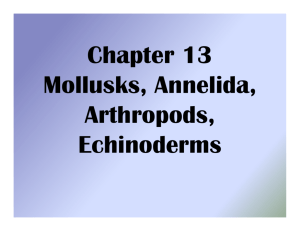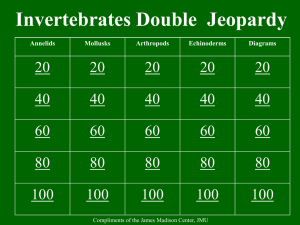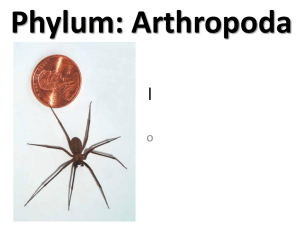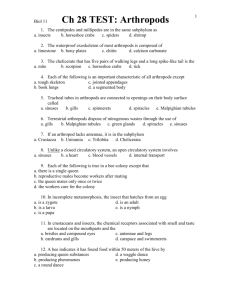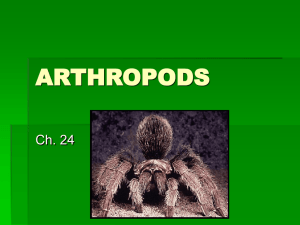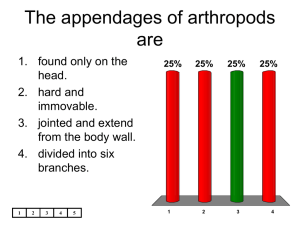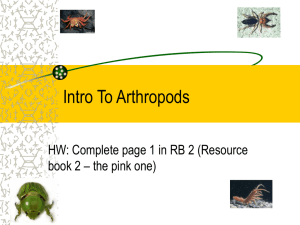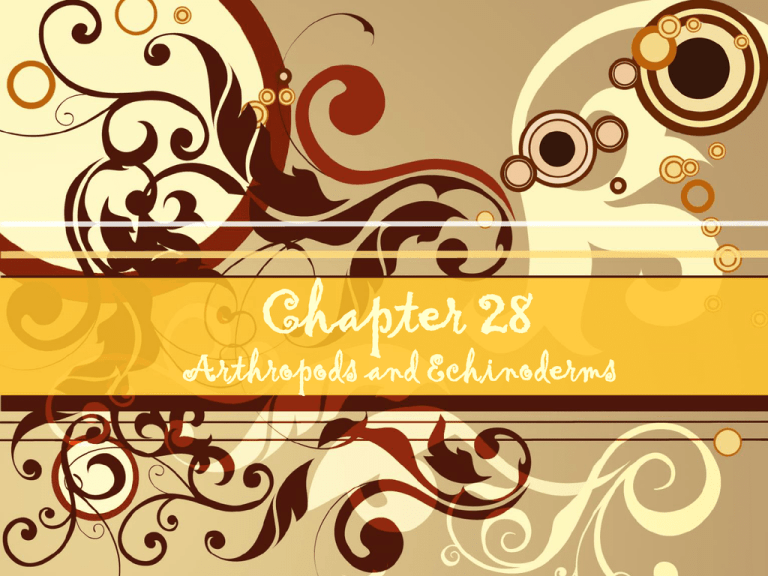
Chapter 28
Arthropods and Echinoderms
Arthropods
“
organism with a tough exoskeleton, jointed
appendages and a segmented body”
Learning Targets 28.1
Identify the defining features of
arthropods.
Describe the important trends in
arthropod evolution.
Explain growth and development of
arthropods
•
•
•
Exoskeleton
• Exoskeleton made of chitin (a
carbohydrate)
• Can be tough and hard or soft and
leathery
• Some have dozens of segments
while others have only 3
• Tough exoskeleton requires joints
between segments and appendages
to move
Feeding
•Display all types
•Mouthparts are modified to fit
feeding behavior
Respiration
• Aquatic arthropods use gills
• Horseshoe crabs use book gills
• Spiders use book lungs
• Terrestrial arthropods use tracheal
tubes (supplies O2 by diffusion-muscles
contract tube)
Book Gills/Lungs
•Several sheets of tissue are
layered like pages in a book
(increases SA)
Internal Transport
•Open circulatory system
•Blood travels through heart to
arteries to smaller vessels to
sinuses and back to heart
Excretion
• Terrestrial - excrete N waste through
•
•
malpighian tubes (remove waste from
blood and add to feces)
Aquatic - N waste removed by diffusion
across gill surfaces
Some have glands near antenna
Response
• Well developed nervous system (All arthropods
have a brain)
• Large compound eyes (may have more that 2000
separate lenses!)
• Some smell w/ antennae and use hair on legs to
taste
• Well developed hearing (ears in strange places
like behind leg)
Movement
Use well developed muscular
system that is controlled by
its nervous system which pulls
and pushes against exoskeleton
•
Reproduction
•Terrestrial arthropods have
internal fertilization
•Some Aquatic arthropods
have external fertilization
Growth and Development
• Tough exoskeleton protects but does not grow and
must be shed (suit of armor)
• Molting – arthropod sheds entire exoskeleton and
produces larger one
–(most molting involves metamorphosis which uses
molting hormone)
• Digests and eats/new skeleton is soft for up to a
day
•Complete
•Incomplete
2 Types of Development
Complete Metamorphosis
• 4 stages – egg, larva, pupa and adult
• Involves interaction b/t molting
hormone and juvenile hormone
Incomplete metamorphosis
•Young look like adults without
wings or sex organs
•Gain these through gradual molts
28-2 A tour of Arthropods
“Trilobites, Chelicerates, Crustaceans and
Uniramians”
•Explain how arthropods are
classified
•Identify the distinguishing
Learning Targets 28.2
features of the three subphyla
of arthropods.
I. Trilobites
II. Chelicerae
a)
b)
Class Merostomata
a)
Horseshoe Crabs
a)
b)
c)
Spiders
Mites and Ticks
Scorpions
Class Arachnida
III. Crustacea
IV. Uniramians
a)
b)
c)
Centipedes
Millipedes
Insects
I. Trilobites
•Now extinct
•Hundreds of lenses in eye
•Divided into many segments
each with a walking leg.
II. Chelicerates
• Chelicerates have mouthparts called
chelicerae and two body sections
and nearly all have four pairs of
legs.
Ex) Horseshoe crabs, spiders, ticks
and scorpions
• 2 part body
–1) Cephalothorax (contains legs, brain,
mouth, eyes)
–2) abdomen (most of internal organs)
• Specialized mouth parts = chelicerates
and pedipalps
• No antennae found in other arthropods
Used to
grab
prey
Contain fangs
which are used to
stab and paralyze
prey
A. Class Meristomata
• Not dangerous
• Tail for plowing through sand
• Lysate in blood is used to test
I. Horseshoe crab (Not so much a crab at all!)
purity of medicines
B. Class Arachnida
• Spiders, mites, ticks, scorpions, and
daddy long legs
• 4 pair of walking legs on cephalothorax
• In addition they have chelicerae (sucking
and biting) and pedipalps (holding prey)
1. Spiders
• All are carnivores
• Capture prey by pouncing or spinning
webs with spinnerets (on abdomen)
• Usually feed on insects (cheliceraeparalyzing venom-enzymes digest-suck)
• Produce protein - silk
Interesting facts about spiders webs:
Whether or not they spin webs they
produce silk
Spider silk is stronger than steel.
Web spinning spiders can spin webs
almost as soon as they hatch!
•
•
•
Sydney funnel web spider
The Brown
recluse
“The culprit”
“The effects”
Day 3
Day 4
Day 5
Day 6
Day 9
Day 10
C. Ticks and Mites
•Parasitic on plants/animals
•Chelicerae are needlelike to pierce
host (some have large teeth to hold
onto host)
Pedipalps have claws for digging and
holding
•
• Other examples of Mites: Causing itching
and painful rashes in Humans and animals
–Chiggers
–Mange
–Scabies
• Ticks can transmit bacteria that causes
disease
–Rocky Mountain spotted fever
–Lyme Disease
D. Scorpions
•Predator in which pedipalps are
modified into claws
•Poisonous tail to sting (enough
venom to feel like wasp sting)
Their appendages may contain a claw or
swimmerets
III. Crustaceans
Typically have two pairs of antennae,
two or three body sections and
chewing mouthparts called mandibles.
Ex) crabs, shrimp, lobster and
crayfish
•
•
• Hard exoskeleton (CaCO )
• 2 pair of antennae (feelers)
• Appendages with 2 branches
• (may be legs, claws or mouthparts,gills)
• Mouthparts called mandible (usually for
3
biting/grinding)
•Typically have head, thorax and
abdomen
•Some may have cephalothorax
•Crayfish, water flea, crabs,
lobsters, shrimp, barnacles
IV. Uniramians
•Largest subphylum of animals
•Single pair of antennae
•Appendages with only a single branch
Learning Target 28.3
• Identify the distinguishing features of
insects.
• Describe two types of development in
insects.
• Explain what types of insects form
societites.
A. Centipedes
• Lacks waterproof exoskeleton
• Wormlike body composed of many leg
bearing segments
• Typically all Carnivores
• All body segments except 1 and last
st
have a pair of appendages
continued
•Pair of poison claws in head
region for killing prey
•15-170 pairs of legs
B. Millipedes
•Eat dead and decaying plant
material
•Each body segment contains
two pair of appendages
C. Insects
• 3 part body (head, thorax, abdomen)
• 3 paired appendages on the thorax
• Many have two pair of wings and a
pair of antennae
Responses to Stimuli
Insects use a multitude of sense organs
1. Compound eyes detect changes in color and
movement.
2. receptors for taste and smell on their mouthparts,
and also on their antennae and legs.
3. Many insects also have well-developed ears. Some
located in odd places Ex) behind the legs in
grasshoppers
Adaptations for Feeding
• three pairs of appendages used as
mouthparts, including a pair of mandibles.
•These mouthparts can take on a variety
of shapes,
Movement and Flight
• Insects have three pairs of legs,
for walking, jumping
•Many insects can fly using two
pairs of wings made of chitin
Metamorphosis
•The growth and development of insects
usually involve metamorphosis, which is a
process of changing shape and form.
•Insects undergo either incomplete
metamorphosis or complete metamorphosis.
Insects and Humans
•Many insects are known for their negative effects.
ex) Termites, moths, bees and wasps, locusts,
mosquitoes.
•Insects also contribute enormously
• Agriculture would be very different without
pollination.
• One third of the food you eat depends on plants
pollinated by animals, including insects.
Insect Communication
•Insects communicate using sound, visual, chemical, and
other types of signals.
•Pheromones are specific chemical messengers that affect
the behavior or development of other individuals of the
same species.
Insect Societies
•Ants, bees, termites, and some of their relatives
form complex associations called societies.
• A society is a group of closely related animals of the
same species that work together for the benefit of the
whole group.
•Castes are individuals which are specialized to perform
particular tasks, or roles.
Communication in Societies
• sophisticated system of communication is necessary
for the functioning of a society.
•Honeybees communicate with complex movements as
well as with pheromones.
•Worker bees convey information about the type,
quality, direction, and distance of a food source by
“dancing.”
* Two types of dances
1. The round dance indicates that food is
fairly close to the hive.
2. The waggle dance indicates that food
is farther away.
Moth has feathery antenna and
butterflies are knobbed
Echinoderms
Echino means spiny and dermis means skin
“spiny skinned animals”
Learning Targets 28-4
Identify the distinguishing features of
echinoderms
Describe the functions carried out by the
water vascular system of echinoderms
Compare the different classes of
echinoderms
•
•
•
What is an Echinoderm?
• Spiny skin
• Internal skeleton (endoskeleton made of
CaCo )
• Water vascular system
• Tube feet (cuplike suction)
• Most adult echinoderms exhibit 5-part
3
radial symmetry
•Echinoderms have a two
sided body
–Oral Surface (mouth side)
–Aboral Surface
Form and Function in Echinoderms
•A unique feature of echinoderms is their water
vascular system.
•A system of internal tubes which are filled
with fluid, that carries out many essential body
functions in echinoderms, including respiration,
circulation, and movement.
• The water vascular system opens to the
exterior at the madreporite.
• Echinoderms filter water in and out through the
madreporite.
• it connects to a ring canal that forms a circle
around the animal’s mouth. From the ring canal, five
radial canals extend along body segments, allowing
water move throughout the entire body.
•Attached to each radial canal are
hundreds of tube feet.
•A tube foot is a structure that
operates much like a suction cup.
•Hundreds of tube feet acting
together create enormous force,
allowing echinoderms to “walk” and
even to pull open shelled prey such
as clams.
Feeding
• Many different feeding styles
–filter feeders, detritus feeders,
herbivores or carnivores
• Some such as star fish can be
predators of bivalves (tube feet open
shell, stomach comes out of mouth and
uses enzymes to digest clam)
Respiration/Circulation/Excretion
•Use water vascular system b/c
they have a large surface area
exposed to water
Some have small skin gills
Solid waste leaves through anus.
Everything else is transported by
the water vascular system
•
•
Response
•Do not have highly organized nervous
system (No brain)
•Enough sensory cells to taste and
smell
•Most can detect light, gravity and
chemicals released by potential prey.
Movement
•Use tube feet
•Use water vascular system like a
hydraulic device
•
•
Reproduction
Reproduce by external fertilization.
Separate sexes
–Eggs produced in ovaries and sperm
produced in testes.
•Indirect development (larva has
bilateral symmetry)
Groups of Echinoderms
There are 7000 species of echinoderms!
•Classes include:
–Sea Urchins
–Sand Dollars
–Brittle stars
–Sea Cucumbers
–Sea Stars
–Sea Lillies
–Feather Stars
Sea Urchins and Sand Dollars
Echinoidea = sand dollars and sea urchin
Brittle Stars
•Ophiuroidea = brittle stars
•Long thin flexible arms
•Move in darkness
•Found on coral reefs
•Can shed an arm when trying to
defend themselves!
Sea Cucumbers
•Holothuriodea = sea cucumbers
(most are detritus)
•Found deep in water
•Secrete a sticky substance that
glues predator to keep it from
moving
Sea Cucumber
Sea Stars (Star Fish)
•Asteroidea = starfish
•most are carnivores feeding on
bivalves
•Common to us b/c they live in
shallow waters
Sea Lilies and Feather Stars
•Crinoidea = sea lilies and feather
stars (filter feeders)
•Many arms
Ecology of Echinoderms
•Sea urchins help control the distribution of
algae and other forms of marine life.
•Sea stars are important carnivores that help
control the numbers of other organisms such
as clams and corals.
•A major threat to coral reefs is the sea star
called the crown-of-thorns.

